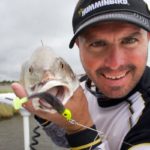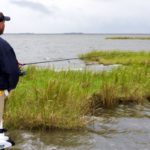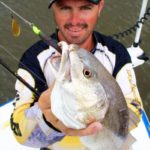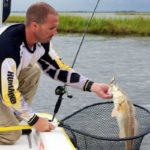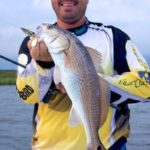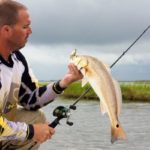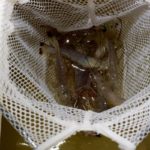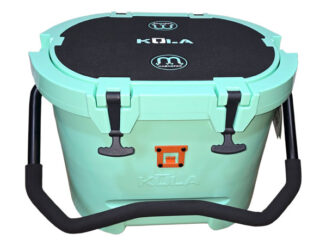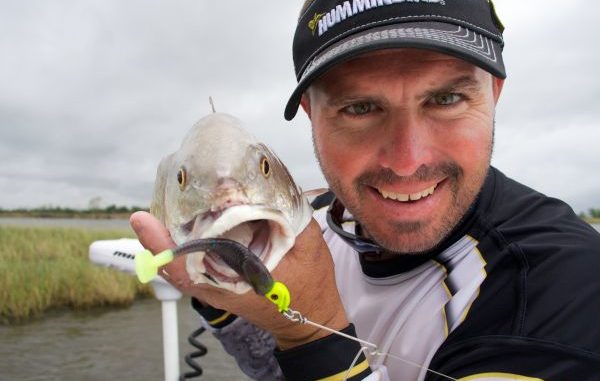
Use this military philosophy to put more fish in your boat, even on tough days.
As a soldier in a field-artillery unit based in Baumholder, Germany, three words drilled into my government-issue brain were shoot, move and communicate.
We had to keep up with a rapidly evolving battlefield in order to support ground forces and reroute requests from fire directions centers directly to the cannons so we could put steel on targets.
Our ability to seamlessly pull this off determined the overall success of the mission.
While tagging along with Capt. John Falterman Jr. with Therapy Charters (985-649-3474) during a recent redfishing trip out of Rigolets Marina, I couldn’t help but mouth “raining down on the enemy; boom, boom.”
It was the last line of a cadence we used to sing every morning during physical training, and watching Falterman’s approach to catching redfish during a challenging post-full-moon morning replete with wind, rain and very little tidal range, I couldn’t help but mentally drift down memory lane.
Out of respect, Falterman would never compare himself or how he fishes to a soldier putting his life on the line for his country. But having been there and done that, I will submit that Falterman’s “stick and move” redfish technique shares a lot of similarities with field artillery’s “shoot, move and communicate” method of operation.
“I stick and move all the time,” Falterman told me as we cast live shrimp under Bomber Paradise Poppers toward the mouth of Bayou DuPont on the south side of Lake Catherine. “I always tell people that fish with me that the fish aren’t going to jump in the boat; we have to find them.”
And in Falterman’s mind, the only way to find redfish is to stick in one spot long enough to determine if fish are there or not. If they’re not, he moves to the next spot.
I added the communication part to Falterman’s strategy after he tried to verbalize how he fishes each spot. I finally figured out that what he was trying to tell me was that he lets the redfish communicate to him how to fish.
Falterman uses his stick-and-move redfish strategy all the time, but he believes it is even more important during tough days like we were experiencing.
A tidal range of 0.2 feet, a line of thunderstorms barreling north out of New Orleans and winds that threatened to chop the surface of Lake Catherine meant we didn’t have much time to spend on the water.
“Less than ideal conditions,” Falterman lamented while quickly trolling from our first spot of broken marsh to another. “When you’ve got very little tide like this, you have to look for spots that concentrate what little water movement there is.
“That’s why we’re fishing the mouth of DuPont as opposed to some other places where I’ve caught them recently.”
On a day when he expected the fishing to be tough, the more spots we could hit the better our chances of putting fish in the boat. What followed after our first move was an on-the-water display of what stick-and-move looks like.
Stick
In Falterman’s lingo, stick means to stay in one spot. Most folks would imagine this means dropping an anchor, but that’s not the case.
“I’ve got an anchor, but it’s in the back of my truck,” Falterman laughed, as he pulled out a remote control-looking device out of his pocket. “Since I’ve been running Minn Kota trolling motors, I’ve upgraded my equipment every year. Now I’m running the i-Pilot with the Spot Lock feature.”
A combination of his trolling motor’s Spot Lock feature and the dual Minn Kota Talon anchoring system on the back of his boat gives Falterman the ultimate in control of how quickly he can stick in one spot.
By sticking in one spot with this high-tech gear, Falterman is able to position his boat right where he wants it to be so he can reach all the high-percentage spots within an area where redfish are likely to be hiding.
One spot we fished in particular provided a perfect example of why it is so important to be able to stick in one spot without having to worry about the boat moving.
In the back corner of the broken marsh in the southwest corner of Lake Catherine, Falterman and I found a spot where the wind was pushing water so hard through a little cut between an island and the bank that it was rippling the water.
Falterman positioned his boat on the downcurrent side of the cut right in the middle of the rushing water. He hit Spot Lock on his remote control, and the boat stayed right there without drifting away from the spot no matter whether he paid attention to it or not.
Move
To tell anglers the importance of moving might seem like a waste of time, but Falterman said the moving part is no less important than sticking or communicating.
“As a matter of fact, moving is the key to the whole thing,” Falterman insisted. “Whether we’re out here today watching the weather go downhill or I’ve got clients out here fishing with me, we’ve only got so much time on the water. We need to make that time count.”
In other words, the more fish Falterman can get into during a day, the higher the final count in his box at the end of the trip. Moving is simply a matter of trying different spots until finding fish.
But Falterman doesn’t move just anywhere, and he rarely cranks his big Yamaha — unless he’s ready to entirely abandon an area.
“I move to what I would consider high-percentage areas,” Falterman explained. “Like today, high-percentage areas would be any small bottleneck that’s concentrating what little tidal current there is. Broken areas, point, pockets — I move around to spots like these and stay away from long, boring straight stretches that show no signs of bait.”
By the end of the day, I observed that Falterman moved very quickly while fishing very slowly. Paradoxical as it is, Falterman wasted no time moving from spot to spot, but once he stuck in an area, he slowed down and made sure to make the most of every opportunity presented.
Communicate
Although Falterman doesn’t acknowledge this phase of his redfish attack by calling it “stick and move,” communicating is exactly what he’s doing with the fish once he sticks down on a spot.
Two redfish on this trip proved that Falterman allows the redfish to tell him how to fish by how they react to different presentations.
The first thing they told him was for us to start popping our corks a littler harder and a lost faster than we had been. Since the fishing was a little slow, Falterman and I decided it would be better to soak our shrimp slowly in likely spots to give the redfish plenty time to react.
But one fish in particular spoke loudly and clearly when my cork washed up against some grass. As I aggressively jerked my rod to free my cork, a redfish engulfed the entire offering but missed.
In the process of my setting the hook, the resulting second hard jerk forced him to bite again.
A little while later, Falterman decided to pull in his cork, and as soon as he did a redfish aggressively attacked the shrimp dangling below it. Just as soon as he unhooked that fish, he put down his cork and picked up a spinnerbait.
“It would be a shame to fish slow all day long if you can catch them fishing fast,” he pointed out as his spinnerbait landed right behind a little grassy clump of land. “That fish bit as my shrimp jerked up toward the surface. If I can make them eat a spinnerbait fished high in the water, there’s no way I’m going back to fishing slow.”
Communicating with the fish is all about paying attention to where and how they bite with different presentations. Falterman accomplishes this by fishing all the high-percentage spots from one side to the other of a little area.
“I catch my points, pockets, moving water — anything I think will hold a fish,” Falterman explained. “I’ll try shrimp on a drop-shot rig, shrimp or Gulp! under a cork, spinnerbaits, spoons and Chatterbaits to see what the fish want.
“Once I figure it out, I can pretty much catch them the same way and the same speed within a given area.”
Fishing is not war, and Falterman has never been a soldier. However, his method of operation on the waters of Southeast Louisiana isn’t too far off what any artillery soldier would consider second nature — shoot, move and communicate.
Or in Falterman’s case — stick, move and communicate.
